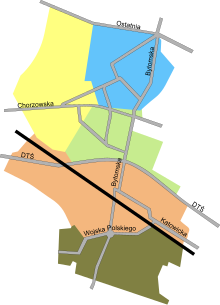Zgoda
| Zgoda | ||
|---|---|---|
 Help on coat of arms |
|
|
| Basic data | ||
| State : | Poland | |
| Voivodeship : | Silesia | |
| District of: | Świętochłowice | |
| Geographic location : | 50 ° 17 ′ N , 18 ° 55 ′ E | |
| Residents : | ||
| Postal code : | 41-600 to 41-608 | |
| Telephone code : | (+48) 32 | |
| License plate : | SW | |
| Economy and Transport | ||
| Street : | Katowice - Chorzów | |
| Next international airport : | Katowice | |
Zgoda (German Eintrachthütte ) is one of five districts of the city Świętochłowice in the Silesian Voivodeship in Poland .
geography
Zgoda occupies the south of the urban area of Świętochłowice. In the north Zgoda borders on the city center and the city of Bytom ( Bytom ) , in the east on Chorzów (Königshütte) , in the south and west on Ruda Śląska .
history
In the area of today's Zgoda in the so-called “ Beuthen Black Forest”, industry gained a foothold very early on, as coal mining began in the young town as early as 1777 and iron ore mining began in 1800 , and by the 1840s there were eleven in the vicinity Coal mines laid out. Franz Anton Egells from Berlin and the Saxon cabinet minister Detlev von Einsiedel are closely connected to the development of the site . On March 14, 1838, they bought a forest area from the city of Beuthen and in the same year the Count of Einsiedel's Societäts Eisenwerk was built there for 32,000 thalers . The plant was later renamed Eintracht-Hochofen-Etablissement and was finally named Eintrachthütte . Originally the ironworks was a joint venture between the two founders, but in 1851 Egells bought the shares in Einsiedeln.
For the workers of this large plant, which had up to 300 employees in the 1860s and up to 700 in the 1870s, living space and institutions were necessary, which led to the creation of the place of the same name. In 1853, for example, a workers' colony was established in Eintrachthütte , which was equipped with a school in 1869 and the Catholic St. Joseph's Church from 1884 to 1885. In 1846 the place was connected to the railway network on the Breslau - Katowice line . Another important industrial company was the Deutschland-Grube (today KWK Polska) and the Bethlen-Falva smelter (today Huta Florian) north of the village, both of which were owned by Henckel von Donnersmarck . The station colony was established around the Eintrachthütte station at this time.
Administratively, Eintrachthütte was part of the community Friedenshütte (today Nowy Bytom; district of Ruda Śląska ) and belonged to the district of Beuthen in the Prussian province of Silesia ; ecclesiastically, the place was raised to its own parish in 1883.
In 1919, the city not only saw the start of the uprisings in Upper Silesia , but also the outbreak of a typhus epidemic . As a result of the division of Upper Silesia after the referendum in Upper Silesia , Eintrachthütte found itself in 1922 as Zgoda (translated: unity ) within the borders of Poland.
On January 1, 1929 Zgoda was ausgemeindet from Nowy Bytom and became a district of Świętochłowice . Zgoda also grew in the interwar period and received new residential areas such as the Grażyński settlement, at the inauguration of which President Ignacy Mościcki was also present. On November 29, 1931, the modern St. Joseph's Church was inaugurated, replacing the old parish church further away from the village, which was demolished in 1932 due to mountain damage .
During the invasion of Poland Zgoda was on 3 September 1939 by the Wehrmacht occupied again renamed Eintrachthütte and was from 1941 part of the Gaus Upper Silesia in the " Greater German Reich ". In 1942 the Eintrachthütte concentration camp was established, which from May 1943 was a satellite camp of the Auschwitz concentration camp . The inmates were used, among other things, for forced labor in the Eintrachthütte (Huta Zgoda). After Zgoda was captured by the Red Army on January 28, 1945, the camp was converted into a Polish labor camp ( Camp Zgoda ). Under his director Salomon Morel , mainly Germans were imprisoned here because of their nationality. The Zgoda camp was finally closed in November 1945.
After the war ended, the place became part of Poland again. In 1947, a mining machinery and equipment factory was established in Huta Zgoda and the factory became one of the most important of its kind in Poland. In addition to many Polish communist politicians, Urho Kekkonen in 1964 and Fidel Castro in 1972 visited Huta Zgoda.
Sons and daughters of the place
- Helena Hoffmann (born February 7, 1910) - religious sister



